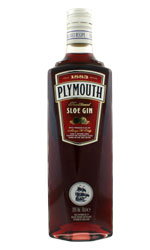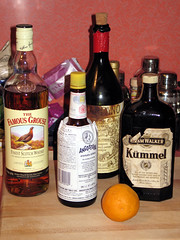An icy Sloe Gin Fizz
New Orleans singer-songwriter Paul Sanchez wrote this opening lyric to his wonderful Christmas song, “I Got Drunk This Christmas”:
I see a stocking hanging
But I don’t know whose it is
I hope Santa’s bringing
An icy sloe gin fizz.
I’ve always loved that song, but I couldn’t quite identify with his cocktail reference … as until last night, I’d never had an icy sloe gin fizz. In fact, until last night, I’d never even tasted realsloe gin. An odd gap in my cocktailian background, true; it was never around much during my earliest drinking days, and every time I saw the stuff in the store (which was not all that often), it tended to be a bottom-shelf liqueur. One sip of that stuff was all I needed to know that what those bottom shelf bottles were passing off as “sloe gin” was not for me.
Real sloe gin is made from sloe berries, the tart blueberry-like fruit of the blackthorn plant (a member of the plum family) and grows primarily in Europe, along with sugar and real gin. It’s a homemade product throughout Britain, with people going out to pick sloes, steeping them in gin and letting them age for the rest of the year, although commercially available brands were also available for decades. The chance that most of those cheap domestic brands would contain both real gin and real sloes was slim to none.
Sloe gin started popping up more and more as an ingredient in various drinks during my later cocktail education, and I began to get curious. After I became a devotee of Plymouth Gin, I found out that Plymouth make a sloe gin as well! The bad news is that it’s not exported to the United States (bah). Well, I’d never let that stop me before. After effusively enthusiastic recommendations from Dr. Cocktail that Plymouth Sloe Gin is indeed The Best There Is (in fact, other than the homemade article, All There Is and None Else Are Worth Bothering), and then reading this taste test in the Guardian …
The best way to drink sloe gin is neat (it is not as alcoholic as ordinary gin, with an ABV of 26%), in a small glass, so that’s how we first tasted it. There were two samples. One was purply, intensely sugary and tasted confected and sickly, like a syrupy cough remedy — that was the Gordon’s. It went straight down the drain. The other had more russety tones, like clotting blood. A waft of bitter almonds and damsons (the sloe is a member of the plum family) came off the glass. Enough sugar had been added to take the edge off the rampant astringency of the fruit, but not so much as to domesticate it. It was delicious — grown-up and very addictive. This one was made by Plymouth (£9.99, from Asda and Safeway).
“Russety, like clotting blood”?! Oh my. Well, the rest of it sounded fantastic, and I knew I had to have some to add to our bar.

I really wanted to try Paul’s icy sloe gin fizz, plus there was still a cocktail in Doc’s book that I couldn’t make because I didn’t have any sloe gin and didn’t want some syrupy, sickly, artificially-flavored bottom-shelf brand. I wanted the best, and Plymouth is the best. One easy internet mail order from Royal Mile Whiskies in the U.K. and one shocking credit card charge later (it cost £1 more to ship the bottles than it cost to buy the bottles, oy), I am now the proud and happy owner of one liter of Plymouth Sloe Gin.
Beautiful tartness, not too sweet and not too powerful, only 52 proof. The waft of bitter almond definitely comes through, and what they said about it being addictive … oh my. This stuff is way too good for me to have to spend £41 for a liter of it with shipping from the U.K., especially at the rate at which we’re likely to be drinking it. Doc recommends Mohawk as an acceptable domestic version (sadly, I don’t recall noticing that brand at any of my usual hooch-buyin’ haunts); I usually only see Hiram Walker, and I’m suspicious of their quality.
The good news is that Plymouth Sloe Gin is now finally available in limited quantities in the U.S., for about $32 a bottle. Hooray!
Okay, I know that Christmas was a month ago, but look what Santa brought me …
Here’s the classic, simple recipe.
Sloe Gin Fizz
(classic)1-1/2 ounces sloe gin.
1 ounce freshly squeezed lemon juice.
1 teaspoon simple syrup.
Soda.Combine with ice in a cocktail shaker and shake for 8-10 seconds.
Strain into an ice-filled 5-ounce Delmonico glass, top with soda and stir.The closest equivalent to a Delmonico glass is described by CocktailDB as a “diner or coffee shop breakfast juice glass.” For taller drinks, double the ingredients and use a Collins glass. By volume, the amount of soda in this drink should be just over 1/3 once the ice is in the glass. Don’t over-soda it!
Yes, I’m aware that in the above photo the drinks are chilled with refrigerator ice. It was all I had on hand at the time. Gimme a frakkin’ break. (This was pointed out in the comments section of the original post by someone who completely ignored the fact that those fizzes are served in vintage 1939 New York World’s Fair Delmonico glasses. Sheesh.)
Here’s the way I prefer to make it these days. I like to kick it up with a bit more gin, but you can leave that out if you like.
Sloe Gin Fizz
(modern)1-1/2 ounces Plymouth Sloe Gin.
1 ounce Plymouth Gin (optional).
3/4 ounce fresh lemon juice.
1 barspoon (tsp) simple syrup.
1 egg white.
Soda.Combine ingredients in a shaker WITHOUT ICE. Dry shake for at least 30 seconds, a minute if you can manage. Add ice and shake again for 20 seconds. Strain over ice into a tall Collins glass, and top with soda water.
Oh man, talk about good …











